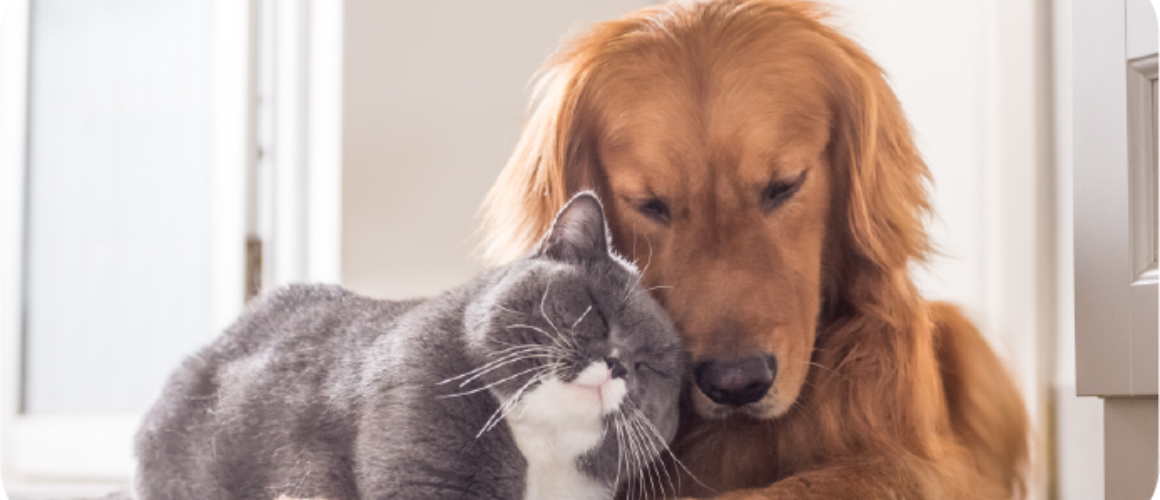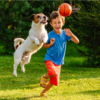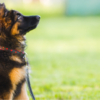Introducing Dogs/Dogs and Cats
Dogs are social animals by nature. However, introducing a new dog into a home

Dogs are social animals by nature. However, introducing a new dog into a home with
another dog present is not always easy. Factors that have an effect on the success of an
introduction include a dog’s early life experiences and appropriate socialisation in
puppyhood. Introducing puppies gradually and calmly using rewards to all species which
he will later encounter certainly helps introductions to dogs and other animals later in life.
Attending suitable puppy socialisation classes is commonly thought to be very valuable
for improving later dog behaviour and can help to reduce the incidence of dog-dog
behaviour problems should you decide to introduce a new dog later on.
Whether you have had your current dog from a puppy or acquired him as an adult, it is
important that you introduce a new dog to your family carefully. Introductions can be
tense for both you and your dogs so appropriate procedures should be followed to
minimise stress.
PREPARING FOR THE INTRODUCTION
• Scent is an important method of communication for dogs. You can help to integrate
the new dog into your home by ensuring that he smells of “home” before being
introduced to your current dog.
• To do this, gather scents from the new dog’s head by gently stroking with a soft cloth
and dabbing this around your home and furniture to mix and spread the scents. You
may also wish to swap the bedding of your animals to enable them to smell each
other prior to meeting.
INTRODUCING YOUR DOGS FOR THE FIRST TIME
• It is best to introduce dogs on neutral territory – a good suggestion is to take the dogs
out for a long walk together. The interest of the walk will make the introduction less
intense and they can all get to know each other as they walk. At least two people
should walk the dogs to ensure safety at all times.
• Keep the dogs on longer leads (e.g. 1.5m length) when they are walking so that you
are not too close if squabbling between the dogs occurs. If squabbling does occur,
walk the dogs away from one another and re-introduce when they are both calm and
relaxed.
• When bringing the new dog home, remove anything they are likely to fight over, such
as toys or bones, before allowing your dogs into the house.
• Attention from members of the family may also be a resource to fight over, so ignore
them until they have settled down.
• Try to ignore any small disagreements and scuffles, although be ready to lead the
dogs away and isolate each of them until they have calmed down.
• Feed your dogs apart until they are used to each other, separate them before
answering the door and do not make such a fuss of the new dog that others feel excluded.
• Care should be taken not to leave them alone together until it is obvious that they
have become friends.
Usually introductions go smoothly and the new dog is treated, and acts, like a visitor. The
relationship between dogs is sorted out during the first few weeks and disagreements are
possible during this time.
If introductions are unsuccessful or you are having difficulty, ask your vet to refer you to a
suitably qualified animal behaviourist. They will check both dogs over first to make sure
there are no underlying injuries or illnesses.
Puppy class trainers and animal behaviourists should have a combination of appropriate
qualifications, up to date knowledge, skills and experience and should work in a way
which doesn’t put the welfare of your animal at risk.
Historically, cats and dogs are considered to not prefer each other’s company, although
they can form close relationships. However, the behaviour of both cats and dogs is
extremely complex. For example, some cats do not cope well with change in their
environment and many cats are happier living without other pets in the house.
How you introduce dogs and cats can make a difference. Once a relationship breaks
down and one of the animals feels threatened, it is difficult to repair. Even if your dog has
lived with a cat before, new cats may not necessarily be tolerated. If they are to become
friends, it is essential that the dog is not allowed to frighten the cat. Taking things slowly
with careful introduction is vital to prevent excessive reactions.
Meeting an unfamiliar dog
Many dogs will be friendly towards unfamiliar people and will not show any signs of aggression when approached, but there may be some who will behave aggressively if someone approaches too closely. Dogs are aggressive in response to unfolding events and it always depends on what they believe is happening to them. When dogs use aggression it is almost invariably because they think that they are under some form of threat. For example, the threat could be to their personal safety, to take away something (or someone) they value highly, or they may feel their territory is threatened. The RSPCA has designed this leaflet to help you recognise the signs of aggression and to give some advice on how to behave around dogs that show these behaviours, helping you to make them feel less threatened and to reduce the chance of aggression towards you.
How can I assess if a dog is showing signs of aggression?
Pay close attention to the dog’s body language.
● In general, you can work out if a dog is likely to be aggressive by paying close attention to his/her body language. In circumstances where a dog might think there is a threat there will usually be warning signs.
● Dogs will often try to remove themselves from the situation, or otherwise avoid a threat in some way, before resorting to attack. A slight stiffening of posture may be the first or only clue but there are a number of other signs to watch out for. Most dogs will give plenty of warning that they may be going to bite.
● They may give “leave me alone” signals like licking their lips, yawning, turning their head or trying to walk away; they may be even more obvious with signals such as raising the hair on their neck and back, growling, snarling, showing their teeth and barking.
Do not make the mistake of thinking that a wagging tail means they are friendly.
● A wagging tail can mean lots of things, including “I am about to bite”! The most obvious signal will be a snap at the air in front of you, which is not a ‘miss’ but a warning that the next one will make contact.
What should I do when an unfamiliar dog approaches?
Stop moving towards the dog.
● If you are visiting a house or out walking, jogging or cycling and a dog approaches, you have probably inadvertently entered what the dog considers to be his/her territory. If the dog runs towards you but is not barking or growling, he/she may just be checking you out and, after a quick sniff to determine you are no threat, may leave you alone.
● Don’t try to touch the dog, or make sudden movements. If you speak reassuringly and keep standing still, he/she may lose interest and leave. If the dog is barking or growling, you are considered to be a threat that must be dealt with so he/she is unlikely to leave.
Stay calm.
● Stand still and face the dog, slightly angling your body away from him/her.
● Keep your body relaxed and on your back foot. You want to give the impression you are leaving calmly.
● Do not try to shoo away, hit or kick the dog as you will be increasing the threat, and will increase the possibility of a full attack. Talk to the dog calmly in a pleasant tone of voice.
● Tell the dog you mean him/her no harm and that you are leaving. If you are cycling, dismount and place the bike between you and the dog. This allows you to slowly wheel it far enough away to remount.
● Do not try to outpace the dog as this may encourage him/her to chase you. Get something as solid as possible between you and the dog.
● If you are delivering something to the house it may be a parcel, a bag or your coat. If you are in the street or park it may be a bench, a lamp post or litter bin. If cycling, use your bicycle
as above.
Watch the dog – but do not stare into his/her face.
● Turn your head slightly to one side and downwards. Watch him/her very carefully out of the corner of your eye.
You may need to move, either behind something or to get away from the dog.
● If the dog does not press home an attack, walk slowly backwards or sideways. Do not let the dog get round behind you; keep moving gently so that you continue to present a half side/front view of your body. Do not make sudden movements or run, just walk slowly away from the dog.
● He/she is not likely to pursue you very far. Keep walking and talking up to the point at which the dog loses interest in you.
What should I do if a dog attacks?
Fend the dog off rather than try to fight back.
● Try to hold something like a briefcase, bag or coat between you and the dog. Very few dogs press home a serious attack and after a snap-bite they will be content that you are leaving.
Do not scream or yell.
● If you know there are people within hearing distance, call to them for help. Stay on your feet and do not corner yourself. Continue to walk slowly away, backwards or sideways, looking down and sideways.
● Talk to the dog reassuringly, fending off if necessary and aiming to place solid objects between you as you leave.
Introducing dogs and cats
PREPARING FOR THE INTRODUCTION (dog and cat)
• Choose a quiet time when the household is calm – avoid festivities, parties, visiting
relatives or friends, and find time to concentrate on calm reassurance for both pets.
• You can integrate the new pet into your home better by ensuring that they smell of
“home” before being introduced as scent is an important communication method for
both species. Gather scents from the new pet’s head by gently stroking with a soft
cloth and dabbing this around your home and furniture to mix and spread the scents.
You may also wish to swap the bedding of your animals to enable them to smell each
other prior to meeting. You could also stroke the dog and cat separately but without
washing your hands to exchange their scents (make sure you wash your hands
afterwards though!).
• Letting the new pet get used to the new smells of the house, and another animal,
before the initial meeting can help in the introduction. For this reason, it is useful to
delay the pets from meeting for a few days or even a week. During this time, keep
them in separate areas of the house, but allow each pet to investigate the other’s
room and bed without actually meeting.
USING A PEN OR LARGE DOG CRATE FOR INTRODUCTIONS
• Problems can arise if initial meetings are allowed to deteriorate into a chase. The best way to avoid this is to use a kitten pen, puppy pen or large dog crate for initial introductions. Kitten pens are metal mesh pens with a door, which can be left open or shut securely and look similar to a dog crate.
• Within the pen or large crate you should provide your cat with a hiding space, this
could be a cardboard box or an igloo type bed – the cat should be able to conceal
themselves.
• As well as being large enough to accommodate a hiding place with the pen or large
crate it must also be big enough for your cat to stand up (including fully on hind legs),
turn around and stretch out fully.
• Put a blanket over the top for more security – but allow for viewing out of one side at
least.
• Ideally it is also best to place a platform within the pen or large crate so that your cat
can choose to get up higher – this can help them feel more secure. If you use a sturdy
cardboard box for the hiding space it can also double up as a platform.
• The cat pen or crate should be placed on a raised surface so it is off the floor or
settee.
• The pen allows the pets to see each other, sniff through the bars and interact without
any attack or intimidation. The bars allow them to be close together but provide
protection at the same time.
• Place the cat or kitten in the pen/large crate and let the dog come into the room. Let the dog come into the room and give both animals attention and calm reassurance.
• Keep your dog on his/her lead to control any interactions. The dog should be kept as
calm as possible on the lead and asked to sit quietly- reward your dog with treats and
praise for remaining calm. Do not force a meeting and remove your dog before
he/she becomes too excitable.
FACE TO FACE MEETINGS
• When both your dog and cat are relaxed and calm with the controlled meetings the
time is right to let your pets meet without the pen/ large crate. Choose a room where
the cat can escape behind furniture, jump up high, or hide if necessary. The cat should
be given a safe position in the room, and the animals should be allowed to get used to
each other gradually. This will take patience.
• Keep your dog calm and on and lead to avoid him or her chasing the cat as this will
upset the relationship and it is likely that it will then take much longer before they
become used to each other.
• Again, associate the presence of the cat with reward for your dog’s calm behaviour.
Praise your dog for calm interactions, and use suitable treats to reward the dog for
good behaviour.
• Once you are sure they are not going to fight or chase, then start to use the whole house – the pets will probably find places to sleep and routines which allow them to live peacefully in the same house while gradually becoming used to and accepting one
another. However, never leave the dog and cat together unattended until you
are happy that they are safe together.
• Make sure that there is enough space and that they can access all of their things
without coming into contact with the other pet if they don’t want to, e.g. food, water,
litter tray.
If you do decide to introduce another pet into your home, seek further advice on the best
way to introduce them. Your vet may be able to refer you to a clinical animal behaviourist
who will have a combination of appropriate qualifications, up to date knowledge, skills
and experience to treat behaviour problems in a way which doesn’t put the welfare of the
animals at risk.







